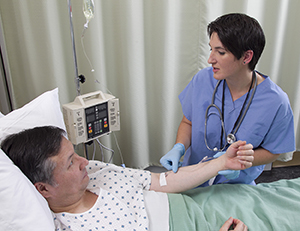Sepsis
Sepsis

Risk factors
Those most at risk for sepsis are:
Infants or older adults
People who have an illness that weakens their immune system, such as cancer, AIDS, or diabetes
People being treated with chemotherapy medicines or radiation, which weakens the immune system
People who have had a transplant
People with a very severe infection such as pneumonia, meningitis, or a urinary tract infection
When to go to the emergency room (ER)
Sepsis is an emergency. Go to the nearest ER if you have a fever with any of these symptoms:
Chills and shaking
Rapid heartbeat and breathing
Trouble breathing
Severe nausea or uncontrolled vomiting
Confusion, disorientation, drowsiness, or dizziness
Decreased urination
Severe pain, including in the back or joints
What to expect in the ER
Blood and urine tests are done to look for bacteria. They also check for organ failure.
Blood, urine, or sputum cultures may be taken. The samples are sent to a lab. They are placed in a special container. Any bacteria should grow in 24 hours.
X-rays or other imaging tests may be done.
A person with sepsis will be admitted to the hospital and treated with antibiotics. Treatment may also include oxygen and intravenous fluids.
Updated:
December 15, 2017
Sources:
Pathophysiology of Sepsis, UpToDate.
Reviewed By:
Image reviewed by StayWell art team.,Lentnek, Arnold, MD,Sather, Rita, RN